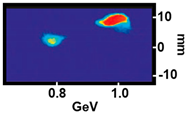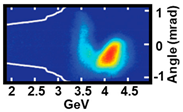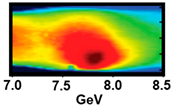Multi-GeV Laser Wakefield Electron Acceleration with PW Lasers
Abstract
:Featured Application
Abstract
1. Introduction
2. Basic Physics of LWFA
3. Multi-GeV LWFA with PW-Class Lasers
3.1. LWFA with Texas PW Laser
3.2. Dual-Stage LWFA with PW Laser at UQBF
3.3. LWFA with Capillary Discharge Plasmas at LBNL
4. Perspective of LWFA with PW Lasers
5. Conclusions
Author Contributions
Funding
Institutional Review Board Statement
Informed Consent Statement
Data Availability Statement
Conflicts of Interest
References
- Tajima, T.; Dawson, J.M. Laser Electron Accelerator. Phys. Rev. Lett. 1979, 43, 267–270. [Google Scholar] [CrossRef] [Green Version]
- Strickland, D.; Mourou, G. Compression of amplified chirped optical pulses. Opt. Commun. 1985, 56, 219–221. [Google Scholar] [CrossRef]
- Nakajima, K.; Fisher, D.; Kawakubo, T.; Nakanishi, H.; Ogata, A.; Kato, Y.; Kitagawa, Y.; Kodama, R.; Mima, K.; Shiraga, H.; et al. Observation of Ultrahigh Gradient Electron Acceleration by a Self-Modulated Intense Short Laser Pulse. Phys. Rev. Lett. 1995, 74, 4428–4431. [Google Scholar] [CrossRef] [PubMed] [Green Version]
- Coverdale, C.A.; Darrow, C.B.; Decker, C.D.; Mori, W.B.; Tzeng, K.C.; Marsh, K.A.; Clayton, C.E.; Joshi, C. Propagation of intense subpicosecond laser pulses through underdense plasmas. Phys. Rev. Lett. 1995, 74, 4659–4662. [Google Scholar] [CrossRef] [PubMed]
- Umstadter, D.; Chen, S.Y.; Maksimchuk, A.; Mourou, G.; Wagner, R. Nonlinear optics in relativistic plasmas and laser wake field acceleration of electrons. Science 1996, 273, 472–475. [Google Scholar] [CrossRef] [PubMed] [Green Version]
- Faure, J.; Glinec, Y.; Pukhov, A.; Kiselev, S. A laser–plasma accelerator producing monoenergetic electron beams. Nature 2004, 431, 541–544. [Google Scholar] [CrossRef] [PubMed]
- Geddes, C.G.R.; Van Tilborg, J.; Esarey, E.; Schroeder, C.B.; Bruhwiler, D.; Nieter, C.; Cary, J.; Leemans, W.P. High-quality electron beams from a laser wakefield accelerator using plasma-channel guiding. Nature 2004, 431, 538–541. [Google Scholar] [CrossRef]
- Mangles, S.; Murphy, C.; Najmudin, Z. Monoenergetic beams of relativistic electrons from intense laser–plasma interactions. Nature 2004, 431, 535–538. [Google Scholar] [CrossRef]
- Albert, F.; Thomas, A.G.R. Applications of laser wakefield accelerator-based light sources. Plasma Phys. Control. Fusion 2016, 58, 103001. [Google Scholar] [CrossRef]
- Esarey, E.; Schroeder, C.; Leemans, W. Physics of laser-driven plasma-based electron accelerators. Rev. Mod. Phys. 2009, 81, 1229–1285. [Google Scholar] [CrossRef]
- Wang, X.; Zgadzaj, R.; Fazel, N.; Li, Z.; Yi, S.; Zhang, X.; Henderson, W.; Chang, Y.-Y.; Korzekwa, R.; Tsai, H.-E.; et al. Quasi-monoenergetic laser-plasma acceleration of electrons to 2 GeV. Nat. Commun. 2013, 4, 1988. [Google Scholar] [CrossRef] [Green Version]
- Gonsalves, A.J.; Nakamura, K.; Daniels, J.; Benedetti, C.; Pieronek, C.; De Raadt, T.C.H.; Steinke, S.; Bin, J.H.; Bulanov, S.S.; Van Tilborg, J.; et al. Petawatt Laser Guiding and Electron Beam Acceleration to 8 GeV in a Laser-Heated Capillary Discharge Waveguide. Phys. Rev. Lett. 2019, 122, 084801. [Google Scholar] [CrossRef] [Green Version]
- Kim, H.T.; Pathak, V.B.; Hong Pae, K.; Lifschitz, A.; Sylla, F.; Shin, J.H.; Hojbota, C.; Lee, S.K.; Sung, J.H.; Lee, H.W.; et al. Stable multi-GeV electron accelerator driven by waveform-controlled PW laser pulses. Sci. Rep. 2017, 7, 1–8. [Google Scholar] [CrossRef]
- Maier, A.R.; Delbos, N.M.; Eichner, T.; Hübner, L.; Jalas, S.; Jeppe, L.; Jolly, S.W.; Kirchen, M.; Leroux, V.; Messner, P.; et al. Decoding Sources of Energy Variability in a Laser-Plasma Accelerator. Phys. Rev. X 2020, 10. [Google Scholar] [CrossRef]
- Danson, C.; Hillier, D.; Hopps, N.; Neely, D. Petawatt class lasers worldwide. High Power Laser Sci. Eng. 2021, 3, 3. [Google Scholar] [CrossRef]
- Gaul, E.W.; Martinez, M.; Blakeney, J.; Jochmann, A.; Ringuette, M.; Hammond, D.; Borger, T.; Escamilla, R.; Douglas, S.; Henderson, W.; et al. Demonstration of a 1.1 petawatt laser based on a hybrid optical parametric chirped pulse amplification/mixed Nd:glass amplifier. Appl. Opt. 2010, 49, 1676–1681. [Google Scholar] [CrossRef]
- Sung, J.H.; Lee, S.K.; Yu, T.J.; Jeong, T.M.; Lee, J. 0.1 Hz 1.0 PW Ti:sapphire laser. Opt. Lett. 2010, 35, 3021–3023. [Google Scholar] [CrossRef]
- Kim, H.T.; Pae, K.H.; Cha, H.J.; Kim, I.J.; Yu, T.J.; Sung, J.H.; Lee, S.K.; Jeong, T.M.; Lee, J. Enhancement of Electron Energy to the Multi-GeV Regime by a Dual-Stage Laser-Wakefield Accelerator Pumped by Petawatt Laser Pulses. Phys. Rev. Lett. 2013, 111, 165002. [Google Scholar] [CrossRef] [Green Version]
- Leemans, W.P.; Gonsalves, A.J.; Mao, H.-S.; Nakamura, K.; Benedetti, C.; Schroeder, C.B.; Tth, C.; Daniels, J.; Mittelberger, D.E.; Bulanov, S.S.; et al. Multi-GeV Electron Beams from Capillary-Discharge-Guided Subpetawatt Laser Pulses in the Self-Trapping Regime. Phys. Rev. Lett. 2014, 113, 245002. [Google Scholar] [CrossRef] [Green Version]
- Mourou, G.A.; Korn, G.; Sandner, W.; Collier, J.L. Science and Technology with Ultra-Intense Lasers ELI-Extreme Light Infrastructure WHITEBOOK; THOSS Media GmbH: Berlin, Germany, 2011. [Google Scholar]
- Zettawatt-Equivalent Ultrashort pulse laser System (ZEUS)—Home for Zettawatt-Equivalent Ultrashort pulse laser System (ZEUS). Available online: https://zeus.engin.umich.edu/ (accessed on 24 May 2021).
- Exawatt Center for Extreme Light Studies (XCELS). Available online: https://xcels.ipfran.ru/img/site-XCELS.pdf (accessed on 22 June 2021).
- Liang, X.; Leng, Y.; Li, R.; Xu, Z. Recent progress on the shanghai superintense ultrafast laser facility (SULF) at SIOM. In High Intensity Lasers and High Field Phenomena; Optical Society of America: Washington, DC, USA, 2020; p. HTh2B.2. [Google Scholar]
- Papadopoulos, D.N.; Le Blanc, C.; Chériaux, G.; Georges, P.; Zou, J.P.; Mennerat, G.; Druon, F.; Pellegrina, A.; Ramirez, P.; Giambruno, F.; et al. The apollon-10P project: Design and current status. In Advanced Solid State Lasers; Optical Society of America: Washington, DC, USA, 2013; p. ATu3A.43. [Google Scholar]
- Sung, J.H.; Lee, H.W.; Yoo, J.Y.; Yoon, J.W.; Lee, C.W.; Yang, J.M.; Son, Y.J.; Jang, Y.H.; Lee, S.K.; Nam, C.H. 4.2 PW, 20 fs Ti:sapphire laser at 0.1 Hz. Opt. Lett. 2017, 42, 2058. [Google Scholar] [CrossRef]
- Lu, W.; Huang, C.; Zhou, M.; Mori, W.B.; Katsouleas, T. Nonlinear theory for relativistic plasma wakefields in the blowout regime. Phys. Rev. Lett. 2006, 10, 165002. [Google Scholar] [CrossRef] [PubMed] [Green Version]
- Pukhov, A.; Meyer-ter-Vehn, J. Laser wake field acceleration: The highly non-linear broken-wave regime. Appl. Phys. B Lasers Opt. 2002, 74, 355–361. [Google Scholar] [CrossRef]
- Faillace, L.; Agustsson, R.; Frigola, P.; Murokh, A.; Rosenzweig, J. Ultra-High Gradient Compact S-Band Linac for Laboratory and Industrial Applications. In Proceedings of the 1st International Particle Accelerator Conference: IPAC’10, Kyoto, Japan, 23–28 May 2010. [Google Scholar]
- Lu, W.; Tzoufras, M.; Joshi, C.; Tsung, F.; Mori, W.; Vieira, J.; Fonseca, R.; Silva, L. Generating multi-GeV electron bunches using single stage laser wakefield acceleration in a 3D nonlinear regime. Phys. Rev. Spec. Top. Accel. Beams 2007, 10, 061301. [Google Scholar] [CrossRef] [Green Version]
- Yu, T.J.; Lee, S.K.; Sung, J.H.; Yoon, J.W.; Jeong, T.M.; Lee, J. Generation of high-contrast, 30 fs, 1.5 PW laser pulses from chirped-pulse amplification Ti:sapphire laser. Opt. Express 2012, 20, 10807–10815. [Google Scholar] [CrossRef]
- Steinke, S.; Van Tilborg, J.; Benedetti, C.; Geddes, C.G.R.; Schroeder, C.B.; Daniels, J.; Swanson, K.K.; Gonsalves, A.J.; Nakamura, K.; Matlis, N.H.; et al. Multistage coupling of independent laser-plasma accelerators. Nature 2016, 530, 190–193. [Google Scholar] [CrossRef]
- Pathak, V.B.; Vieira, J.; Fonseca, R.A.; Silva, L.O. Effect of the frequency chirp on laser wakefield acceleration New Journal of Physics Effect of the frequency chirp on laser wakefield acceleration. New J. Phys. 2012, 14, 23057–23070. [Google Scholar] [CrossRef] [Green Version]
- Shin, J.; Kim, H.T.; Pathak, V.B.; Hojbota, C.; Lee, S.K.; Sung, J.H.; Lee, H.W.; Yoon, J.W.; Jeon, C.; Nakajima, K.; et al. Quasi-monoenergetic multi-GeV electron acceleration by optimizing the spatial and spectral phases of PW laser pulses. Plasma Phys. Control. Fusion 2018, 60, 064007. [Google Scholar] [CrossRef]
- Spence, D.J.; Butler, A.; Hooker, S.M. Gas-filled capillary discharge waveguides. J. Opt. Soc. Am. B 2003, 20, 138. [Google Scholar] [CrossRef]
- Lu, H.; Liu, M.; Wang, W.; Wang, C.; Liu, J.; Deng, A.; Xu, J.; Xia, C.; Li, W.; Zhang, H.; et al. Laser wakefield acceleration of electron beams beyond 1 GeV from an ablative capillary discharge waveguide. Appl. Phys. Lett. 2011, 99, 091502. [Google Scholar] [CrossRef]
- Jang, D.G.; Kim, M.S.; Nam, I.H.; Uhm, H.S.; Suk, H. Density evolution measurement of hydrogen plasma in capillary discharge by spectroscopy and interferometry methods. Appl. Phys. Lett. 2011, 99, 141502. [Google Scholar] [CrossRef]
- Leemans, W.P.; Nagler, B.; Gonsalves, A.J.; Tóth, C.; Nakamura, K.; Geddes, C.G.R.; Esarey, E.; Schroeder, C.B.; Hooker, S.M. GeV electron beams from a centimetre-scale accelerator. Nat. Phys. 2006, 2, 696–699. [Google Scholar] [CrossRef]
- Li, W.; Gan, Z.; Yu, L.; Wang, C.; Liu, Y.; Guo, Z.; Xu, L.; Xu, M.; Hang, Y.; Xu, Y.; et al. 339 J high-energy Ti:sapphire chirped-pulse amplifier for 10 PW laser facility. Opt. Lett. 2018, 43, 5681. [Google Scholar] [CrossRef]
- Pak, A.; Marsh, K.A.; Martins, S.F.; Lu, W.; Mori, W.B.; Joshi, C. Injection and Trapping of Tunnel-Ionized Electrons into Laser-Produced Wakes. Phys. Rev. Lett. 2010, 104, 025003. [Google Scholar] [CrossRef] [Green Version]
- Clayton, C.E.; Ralph, J.E.; Albert, F.; Fonseca, R.A.; Glenzer, S.H.; Joshi, C.; Lu, W.; Marsh, K.A.; Martins, S.F.; Mori, W.B.; et al. Self-guided laser wakefield acceleration beyond 1 GeV using ionization-induced injection. Phys. Rev. Lett. 2010, 105, 105003. [Google Scholar] [CrossRef]
- Mirzaie, M.; Li, S.; Zeng, M.; Hafz, N.A.M.; Chen, M.; Li, G.Y.; Zhu, Q.J.; Liao, H.; Sokollik, T.; Liu, F.; et al. Demonstration of self-truncated ionization injection for GeV electron beams. Sci. Rep. 2015, 5, 14659. [Google Scholar] [CrossRef] [Green Version]
- Thaury, C.; Guillaume, E.; Lifschitz, A.; Ta Phuoc, K.; Hansson, M.; Grittani, G.; Gautier, J.; Goddet, J.-P.; Tafzi, A.; Lundh, O.; et al. Shock assisted ionization injection in laser-plasma accelerators. Sci. Rep. 2015, 5, 16310. [Google Scholar] [CrossRef] [Green Version]
- Götzfried, J.; Döpp, A.; Gilljohann, M.F.; Foerster, F.M.; Ding, H.; Schindler, S.; Schilling, G.; Buck, A.; Veisz, L.; Karsch, S. Physics of High-Charge Electron Beams in Laser-Plasma Wakefields. Phys. Rev. X 2020, 10, 041015. [Google Scholar] [CrossRef]
- Cho, M.H.; Pathak, V.B.; Kim, H.T.; Nam, C.H. Controlled electron injection facilitated by nanoparticles for laser wakefield acceleration. Sci. Rep. 2018. [Google Scholar] [CrossRef] [Green Version]
- Aniculaesei, C.; Pathak, V.B.; Oh, K.H.; Singh, P.K.; Lee, B.R.; Hojbota, C.I.; Pak, T.G.; Brunetti, E.; Yoo, B.J.; Sung, J.H.; et al. Proof-of-Principle Experiment for Nanoparticle-Assisted Laser Wakefield Electron Acceleration. Phys. Rev. Appl. 2019, 12, 044041. [Google Scholar] [CrossRef] [Green Version]
- Pathak, V.B.; Kim, H.T.; Vieira, J.; Silva, L.O.; Nam, C.H. All optical dual stage laser wakefield acceleration driven by two-color laser pulses. Sci. Rep. 2018, 8, 11772. [Google Scholar] [CrossRef] [Green Version]
- Aniculaesei, C.; Pathak, V.B.; Kim, H.T.; Oh, K.H.; Yoo, B.J.; Brunetti, E.; Jang, Y.H.; Hojbota, C.I.; Shin, J.H.; Jeon, J.H.; et al. Electron energy increase in a laser wakefield accelerator using up-ramp plasma density profiles. Sci. Rep. 2019, 9, 1–7. [Google Scholar] [CrossRef]
- Tomkus, V.; Girdauskas, V.; Dudutis, J.; Gečys, P.; Stankevič, V.; Račiukaitis, G.; Gallardo González, I.; Guénot, D.; Svensson, J.B.; Persson, A.; et al. Laser wakefield accelerated electron beams and betatron radiation from multijet gas targets. Sci. Rep. 2020, 10, 1–17. [Google Scholar] [CrossRef] [PubMed]
- Ke, L.T.; Feng, K.; Wang, W.T.; Qin, Z.Y.; Yu, C.H.; Wu, Y.; Chen, Y.; Qi, R.; Zhang, Z.J.; Xu, Y.; et al. Near-GeV Electron Beams at a Few Per-Mille Level from a Laser Wakefield Accelerator via Density-Tailored Plasma. Phys. Rev. Lett. 2021, 126, 214801. [Google Scholar] [CrossRef] [PubMed]
- Miao, B.; Feder, L.; Shrock, J.E.; Goffin, A.; Milchberg, H.M. Optical Guiding in Meter-Scale Plasma Waveguides. Phys. Rev. Lett. 2020, 125, 074801. [Google Scholar] [CrossRef] [PubMed]
- Ehrlich, Y.; Cohen, C.; Zigler, A.; Krall, J.; Sprangle, P.; Esarey, E. Guiding of high intensity laser pulses in straight and curved plasma channel experiments. Phys. Rev. Lett. 1996, 77, 4186–4189. [Google Scholar] [CrossRef] [PubMed] [Green Version]
- Caizergues, C.; Smartsev, S.; Malka, V.; Thaury, C. Phase-locked laser-wakefield electron acceleration. Nat. Photonics 2020, 14, 475–479. [Google Scholar] [CrossRef]
- Palastro, J.P.; Shaw, J.L.; Franke, P.; Ramsey, D.; Simpson, T.T.; Froula, D.H. Dephasingless Laser Wakefield Acceleration. Phys. Rev. Lett. 2020, 124, 134802. [Google Scholar] [CrossRef]
- Froula, D.H.; Turnbull, D.; Davies, A.S.; Kessler, T.J.; Haberberger, D.; Palastro, J.P.; Bahk, S.W.; Begishev, I.A.; Boni, R.; Bucht, S.; et al. Spatiotemporal control of laser intensity. Nat. Photonics 2018, 12, 262–265. [Google Scholar] [CrossRef]


| Shot | a | b | c |
|---|---|---|---|
| Spectrum |  |  |  |
| Epeak (GeV) | 2.0 ± 0.1 | 1.8 ± 0.1 | 0.95 ± 0.1 |
| Energy spread (%) | 10 | 8 | 11 |
| Divergence (mrad) | 0.6 ± 0.1 | 0.5 ± 0.1 | 0.5 ± 0.1 |
| Charge in peak (pC) | 63 ± 8 | 34 ± 5 | 13 ± 2 |
| Plasma density (1017 cm−3) | 4.8 ± 0.1 | 3.4 ± 0.1 | 2.1 ± 0.1 |
| Laser energy (J) | 100 ± 5 | 120 ± 6 | 129 ± 6 |
| Laser pulse duration (fs) | 160 ± 10 | 150 ± 10 | 160 ± 10 |
| Experiment 1 | Experiment 2 | Experiment 3 | |
|---|---|---|---|
| Spectrum |  |  |  |
| Channel length (cm) | 3.3 | 9 | 20 |
| Plasma density (1017 cm−3) | 43 | 7 | 3.4 |
| Laser power (TW) | 40 | 300 | 850 |
| Laser pulse duration (fs) | 40 | 40 | 40 |
| Epeak (GeV) | 1 | 4.2 | 7.8 |
| Energy spread (%) | 1.6 (r.m.s.) | 6 (r.m.s.) | ~10 (FWHM) |
| Divergence (mrad) | 1.6 (r.m.s.) | 0.3 (r.m.s.) | 0.2 (FWHM) |
| Charge in peak (pC) | ~30 | 6 | 5 |
Publisher’s Note: MDPI stays neutral with regard to jurisdictional claims in published maps and institutional affiliations. |
© 2021 by the authors. Licensee MDPI, Basel, Switzerland. This article is an open access article distributed under the terms and conditions of the Creative Commons Attribution (CC BY) license (https://creativecommons.org/licenses/by/4.0/).
Share and Cite
Kim, H.T.; Pathak, V.B.; Hojbota, C.I.; Mirzaie, M.; Pae, K.H.; Kim, C.M.; Yoon, J.W.; Sung, J.H.; Lee, S.K. Multi-GeV Laser Wakefield Electron Acceleration with PW Lasers. Appl. Sci. 2021, 11, 5831. https://doi.org/10.3390/app11135831
Kim HT, Pathak VB, Hojbota CI, Mirzaie M, Pae KH, Kim CM, Yoon JW, Sung JH, Lee SK. Multi-GeV Laser Wakefield Electron Acceleration with PW Lasers. Applied Sciences. 2021; 11(13):5831. https://doi.org/10.3390/app11135831
Chicago/Turabian StyleKim, Hyung Taek, Vishwa Bandhu Pathak, Calin Ioan Hojbota, Mohammad Mirzaie, Ki Hong Pae, Chul Min Kim, Jin Woo Yoon, Jae Hee Sung, and Seong Ku Lee. 2021. "Multi-GeV Laser Wakefield Electron Acceleration with PW Lasers" Applied Sciences 11, no. 13: 5831. https://doi.org/10.3390/app11135831







